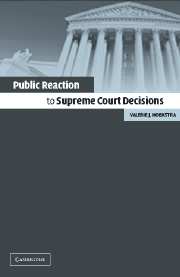Book contents
- Frontmatter
- Contents
- List of Figures
- List of Tables
- Acknowledgments
- 1 The High-Wire Act: The Supreme Court and Public Opinion
- 2 From the Marble Temple to Main Street: Placing the Cases in Political and Legal Context
- 3 Media Attention and Public Awareness
- 4 Changing Hearts and Minds? Examining the Legitimation Hypothesis
- 5 Public Support for the Supreme Court
- 6 Conclusion: Balancing Independence and Support
- Appendix A Sampling
- Appendix B Survey Instruments Included in the Analysis
- Appendix C Local and National Media Coverage of a Sample of Supreme Court Cases: 1996–97 Term
- Appendix D Statistical Issues with the Analysis of Panel Data
- References
- Index
5 - Public Support for the Supreme Court
Published online by Cambridge University Press: 02 September 2009
- Frontmatter
- Contents
- List of Figures
- List of Tables
- Acknowledgments
- 1 The High-Wire Act: The Supreme Court and Public Opinion
- 2 From the Marble Temple to Main Street: Placing the Cases in Political and Legal Context
- 3 Media Attention and Public Awareness
- 4 Changing Hearts and Minds? Examining the Legitimation Hypothesis
- 5 Public Support for the Supreme Court
- 6 Conclusion: Balancing Independence and Support
- Appendix A Sampling
- Appendix B Survey Instruments Included in the Analysis
- Appendix C Local and National Media Coverage of a Sample of Supreme Court Cases: 1996–97 Term
- Appendix D Statistical Issues with the Analysis of Panel Data
- References
- Index
Summary
Whatever may be the merits or demerits of a poll-driven executive or a poll-driven legislature, the specter of a poll-driven judiciary is not an appealing one. So the search for greater public trust and confidence in the judiciary must be pursued consistently with the idea of judicial independence.
–Chief Justice William H. RehnquistINTRODUCTION
Chief Justice Rehnquist raises an important issue. Many scholars believe that while the members of the Court need not rely on public support in the same way as legislators or other elected officials, the specter of public disapproval apparently still looms large. Why should the justices care about public support if they are appointed to life tenured positions, cannot be overturned by any higher court, and are not likely to pursue higher office? The most important reason they should care is that public trust and confidence are precious political resources. Recall Felix Frankfurter's words in Baker v. Carr from Chapter 1. In that case, he said, “The Court's authority – possessed of neither the purse nor the sword – ultimately rests on sustained public confidence in its moral sanction.” Public confidence can harbor the institution from attacks initiated by other branches of government and may also increase the likelihood of compliance with its decisions. But, the question remains as to whether popular decisions increase confidence in the Court and whether unpopular decisions decrease public confidence.
If Court decisions do not affect support for the institution, the justices need not worry about public reaction to those decisions.
- Type
- Chapter
- Information
- Public Reaction to Supreme Court Decisions , pp. 115 - 147Publisher: Cambridge University PressPrint publication year: 2003



